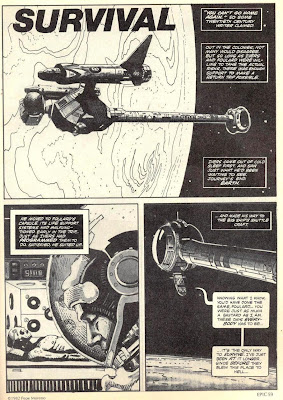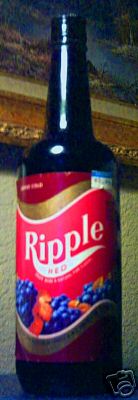'Survival' by Pepe Moreno
from the August 1982 issue of Epic IllustratedWednesday, August 29, 2012
Labels:
Survival by Moreno
Sunday, August 26, 2012
Book Review: 'Second Game' by Charles V. De Vet and Katherine MacLean
4 / 5 Stars
SF fans will want this volume in their collections.
4 / 5 Stars
‘Second Game’ has a rather complex history. It was first published in Astounding in March 1958 as a short story of the same title. Then an expanded version was released in 1962 as ‘Cosmic Checkmate’, part of Ace Double F-149.
The novel was expanded again for this May, 1981 DAW Books publication (No. 435, 158 pp., cover art by Michael Mariano).De Vet wrote a sequel, ‘Third Game’, which appeared as a novelette in the February 1991 issue of Analog Science Fiction / Science Fact.
The novel opens with the phrase: I’ll beat you the second game.Drafted into duty as a Federation spy, Terran Leonard Stromberg undergoes plastic surgery, and travels to the planet Veldq, where he passes as a member of the humanoid race living on that world.
Stromberg’s mission is to discover why the Veldqans refuse contact with the Federation – and why the Veldqans destroyed an entire Federation diplomatic fleet that sought to ignore that proscription. The ease with which the Veldqans destroyed the fleet is disturbing to the Federation, which expected little opposition against its haughty imposition on Veldq.A master chess player, Stromberg has studied the Veldqan counterpart to chess, a game called (simply) the Game. As part of his disguise on Veldq, Stromberg assumes a persona as a skilled player of the Game, part of his strategy to learn as much as he can about Veldqan culture and military capabilities, withour arousing suspicion.
Stromberg sets up his board at a Veldqan fair and issues a challenge to any and all players: he’ll beat them the second game.I won’t disclose any spoilers, save to reveal that as Stromberg’s quest progresses, he becomes increasingly vulnerable to discovery and arrest by the Veldqans. But if Stromberg is to save the Federation from defeat, he’ll need to risk life and limb, because the Veldqans are marshaling for an invasion of the Federation….an invasion they will surely win.
Unless Leonard Stromberg can find a way to win the Second Game……I first read the 1962 novelette version of ‘Second Game’, and in my opinion, it’s the best version.
This DAW expansion, while engaging, shows too many signs of padding, and the crisp, concise character of the original narrative is lost on the wayside.
Sections dealing with an inter-racial Love Jones (featuring an insatiable alien BBW - ! ), in particular, comes across as contrived - even cheesy.
However, those readers for whom this DAW volume is their first exposure to ‘Second Game’, may find less fault with this expanded text than I did.Either way, novelette or DAW novel, ‘Second Game’ continues to be one of the best sf pieces from the late 50s / early 60s. There is little in the way of traditional action; no blasters are fired at our hero, and any space battles that take place are something of a sideline among the overall narrative.
However, ‘Second Game’ succeeds in making the chess matches of the Game, and the parallel political maneuverings between Stromberg and the Veldqans, interesting all the way till the final sentence. SF fans will want this volume in their collections.
Labels:
Second Game
Friday, August 24, 2012
'Hungry Chuck Biscuits' by Daniel Clowes
'Hungry Chuck Biscuits', a character created by the artist Daniel Clowes, appeared in a number of underground comix in the early 70s.
This episode, from the second issue of the comix Teenage Horizons of Shangri-La, follows our hero as he tries to rid himself of intestinal worms - using Bosco chocolate syrup (?!). The original slideshow is available here.
Uniquely demented humor.....even Heavy Metal never ran anything quite like this - !
Labels:
Hungry Chuck Biscuits
Wednesday, August 22, 2012
'New Ark City' by Caza
from the August, 1979 issue of Heavy MetalIt's August, 1979, and amidst the never-ending, annoying rotation of 'My Sharona' on the FM radio stations, there are some good songs getting precious airplay, including Ian Gomm's 'Hold On'.
Anyone picking up the August issue of Heavy Metal magazine will find that one of the best pieces in the issue is, not surprisingly, by Caza.
Labels:
New Ark City
Monday, August 20, 2012
Harry Harrison dies
March 12, 1925 - August 15, 2012
March 12, 1925 - August 15, 2012
Born Henry Maxwell Dempsey in Stanford, CT, Harry Harrison was a major sf writer for nearly 5 decades, from the 1960s on till the 2000s.
His books were a major part of my reading during that time, starting with The Stainless Steel Rat series and the Deathworld series of the 60s and 70s; the Eden series of the 1980s; The Hammer and the Cross series of the 1990s, and the Stars and Stripes Forever series of the 2000s.
And a bunch of singleton novels, stories, and Harrison-edited anthologies all along the way.
Harrison was a prolific author, and not every one of his novels or stories were gems. But plenty of them were, more than enough to justify him as one of the best sf authors of his time.
Labels:
Harry Harrison 1925 - 2012
Saturday, August 18, 2012
Book Review: 'The Unreal People' by Martin Siegel
1 / 5 Stars
‘The Unreal People’ (158 pp) was published by Lancer Books in 1973; the cover art is by Ron Walotsky.
Lancer was a major 'budget' publisher of paperback sf and fantasy titles in the late 60s and early 70s. Much of what they printed was mediocre. Some titles were downright awful, but once in a while there were also those rare titles that were above-average.
Unfortunately, ‘The Unreal People’ is in the ‘awful’ category. I gave up on it halfway through my reading.
The novel is set in the future, in the aftermath of World War Three. Humanity has since retreated from the devastated surface to live in a crowded underground city. The populace is kept compliant, and moderately free of depression, via a regimen of psychotropic drugs issued by the ruling cabal.
The lower depths of the city are occupied by half-starved, mutant, homicidal scavengers, and a police force serves to keep them from penetrating to the more affluent sectors of the city.
The main character is a policeman named Conrad, second in command of the ‘Narko Skwad’. As the novel opens, the populace of the city is growing increasingly restive, a state partially induced by the rumors of people who have escaped the city, to live lives of fulfillment and ease on the now-reborn surface of the Earth. The rioters want permission to emigrate to the surface, something the ruling oligarchy is loath to allow.
Conrad and the Skwad brutally subdue the rioters, an action that deepens Conrad' s misgivings of the ruling oligarchy. He decides to flee to the surface. But his escape is complicated by the knowledge that friends of his, deemed subversives by the oligarchy, are going to be assassinated. Can Conrad rescue his friends, and escape with them to the surface, before the government realizes he has switched sides ?
The writing in ‘Unreal People’ is bad, even by the relaxed standards of New Wave sf of the early 70s.
Author Siegel regularly uses a mangled, stream-of-consciousness effect to bring us deep into the psyche of selected characters. Here’s a sample passage of the wordy, empty prose that occupies much of the book:
You don’t, can’t, interfere in the jungle unless you want to live there, he told himself. And that’s flat. No more. He wished it didn’t feel it was an escape of his reality. And then – why the hell not escape ? That’s what the kid’s like, right ? He didn’t know. Satin wanted out and got out. Maybe the kid….not the point, a voice said. Hearing voices today. No point in getting into this. That’s the point. Unless you want to enter it, stay out of the jungle. And I’m leaving.
As a regular reader of New Wave sf, I have acquired a great tolerance for the prose styles employed by that Movement and its imitators, but I could only take so much of ‘The Unreal People’ before bailing out. This one is best avoided !
Labels:
The Unreal People
Thursday, August 16, 2012
Abelmar Jones: 'Bad Day 'Cross 110th Street'
by Bill Dubay and Alex Nino
Vintage Ghetto Action, including 'right - on' 70s phrases like:
"hot 'nuff t' fry chitlin's on the roof"
"Honkieland"
"Jeezus Lawd !"
and ending the adventure of our two young homeboys (actually, the term 'homeboy' was not in use in 1978....) with a bottle of Gallo 'Ripple' brand pop wine......
Abelmar Jones was a recurring character in several Eerie issues in the late 70s. His adventures involved supernatural phenomena that happened to take place in the ghetto, as opposed to Transylvania or the desolate heaths of England.
'Bad Day 'Cross 110th Street' was the first of the Abelmar Jones stories.
I'll be posting more of his adventures in the coming weeks.
Labels:
Abelmar Jones
Monday, August 13, 2012
'Heavy Metal' magazine August 1982
The latest issue of Heavy Metal magazine is on the stands, featuring 'Voltomat', by Thomas Warkentin, on the front cover, and "Just A Bit Off the Top, Mac !", by Christopher Mark Brennan, on the back cover.
The Dossier is the usual lively grab-bag of reviews and commentary.
Rok Critic Lou Stathis examines what he calls 'Ear Movies', i.e., soundtrack / instrumental albums by the likes of Vangelis and Georgio Moroder. Back in the early 80s the concept of Chill Music didn't really exist, and there were no internet or satellite radio channels devoted to the genre. So even if groups like The Thievery Corporation had existed in 1982, there was no real broadcasting outlet for them, save perhaps as a Sunday night show on the college radio stations.
The movie reviews cover gems such as John Carpenter's The Thing, as well as E. T., Poltergeist, and Tron.
There is an interview with the British sf author Brian Aldiss, who provides his list of top-ten books 'To Be Stuck In An Indian Urinal With'.
One promising development is a new serial by Berni Wrightson, titled 'Freak Show'; this would become one of Wrightson's more memorable comic art creations.
I've posted the 'Voyage of Those Forgotten' entry below.
Labels:
''Heavy Metal' August 1982
Friday, August 10, 2012
Sabre issue 2
'Sabre' issue 2
Eclipse Comics, October 1982Issue 2 - which reprints, in colored form, the second half of the 1978 original Sabre graphic novel - opens with some skilful artwork from Paul Gulacy depicting our hero in the midst of interrogation. This provokes some flashbacks which reveal more of Sabre's past, such as his growing up in the 'hood under conditions of violence and privation.....
Don McGregor's prose, as usual, encrusts every page, but it can't totally obscure Gulacy's rendering of a fight sequence between Sabre and the psychopathic Overseer.
So closes the first two issues of Sabre, the color comic book. Issue three would inaugurate all-new content, and will be the topic of a future Sabre posting.
Labels:
Sabre (1982) issue 2
Subscribe to:
Posts (Atom)















































































